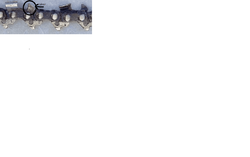How long can you expect a chain to last on your saw? Years?
Let me say that my saw is not a professional saw - Echo 370 and the chain is the one that comes with the saw and spare chains sold at Home Depot. I am guessing it's a safety chain - nothing fancy. When the chain is new - it cuts amazingly well and is good for awhile. Then it reaches a point where it's not performing like it should. I use the corresponding round file that matches up with the chain and point it up.
I still could learn a thing or two about sharpening the chain. I do NOT have a flat file to use on the bump in front of the tooth. Sorry my terminology is not up to speed. Maybe not filing this part of the chain is causing my problems?
I scrounge alot of trees from construction sites so some of the wood is dirty - but I do my best to make my cutting area clean and I avoid making contact with anything that would instantly dull the chain (like the ground). I am not sure of the species of wood either. About the only one I can identify is the cherry. Most of it's been laying around awhile. None of it is fresh green wood.
My routine is: When I reach a stopping point, I fill up the fuel, bar oil, and clean/adjust the bar and chain tension and file the chain. Usually 2-3 files per tooth or so proper angle and direction. And then I get back to cutting. It cuts just fine. But there comes a time when sharpening the chain this way- just doesn't get me the performance I expect. I wonder if the chain is beyond use (poor quality) or am I wearing out these cheap files? Or do I need a flat file for the gauge bump thing in front of the tooth?
Chains are cheap enough, I just threw out 2 and bought 2 new ones. I cut 8 cords of wood with the 2 I threw out. Seems like you could get more out of them? I'm sure being new to this - I am rough on them. Which makes me wonder is it me? Is it cheap chains, cheap files, wrong sharpening technique? None of the teeth were broken - should I have kept those chains and worked on them alittle more? The local shop will sharpen my chains - but it's $ 10 a chain and buying new ones are just $ 16.
Any help you could offer this chainsaw rookie is appreciated. Or is it acceptable to wear a chain or two out in two years time?
Let me say that my saw is not a professional saw - Echo 370 and the chain is the one that comes with the saw and spare chains sold at Home Depot. I am guessing it's a safety chain - nothing fancy. When the chain is new - it cuts amazingly well and is good for awhile. Then it reaches a point where it's not performing like it should. I use the corresponding round file that matches up with the chain and point it up.
I still could learn a thing or two about sharpening the chain. I do NOT have a flat file to use on the bump in front of the tooth. Sorry my terminology is not up to speed. Maybe not filing this part of the chain is causing my problems?
I scrounge alot of trees from construction sites so some of the wood is dirty - but I do my best to make my cutting area clean and I avoid making contact with anything that would instantly dull the chain (like the ground). I am not sure of the species of wood either. About the only one I can identify is the cherry. Most of it's been laying around awhile. None of it is fresh green wood.
My routine is: When I reach a stopping point, I fill up the fuel, bar oil, and clean/adjust the bar and chain tension and file the chain. Usually 2-3 files per tooth or so proper angle and direction. And then I get back to cutting. It cuts just fine. But there comes a time when sharpening the chain this way- just doesn't get me the performance I expect. I wonder if the chain is beyond use (poor quality) or am I wearing out these cheap files? Or do I need a flat file for the gauge bump thing in front of the tooth?
Chains are cheap enough, I just threw out 2 and bought 2 new ones. I cut 8 cords of wood with the 2 I threw out. Seems like you could get more out of them? I'm sure being new to this - I am rough on them. Which makes me wonder is it me? Is it cheap chains, cheap files, wrong sharpening technique? None of the teeth were broken - should I have kept those chains and worked on them alittle more? The local shop will sharpen my chains - but it's $ 10 a chain and buying new ones are just $ 16.
Any help you could offer this chainsaw rookie is appreciated. Or is it acceptable to wear a chain or two out in two years time?



